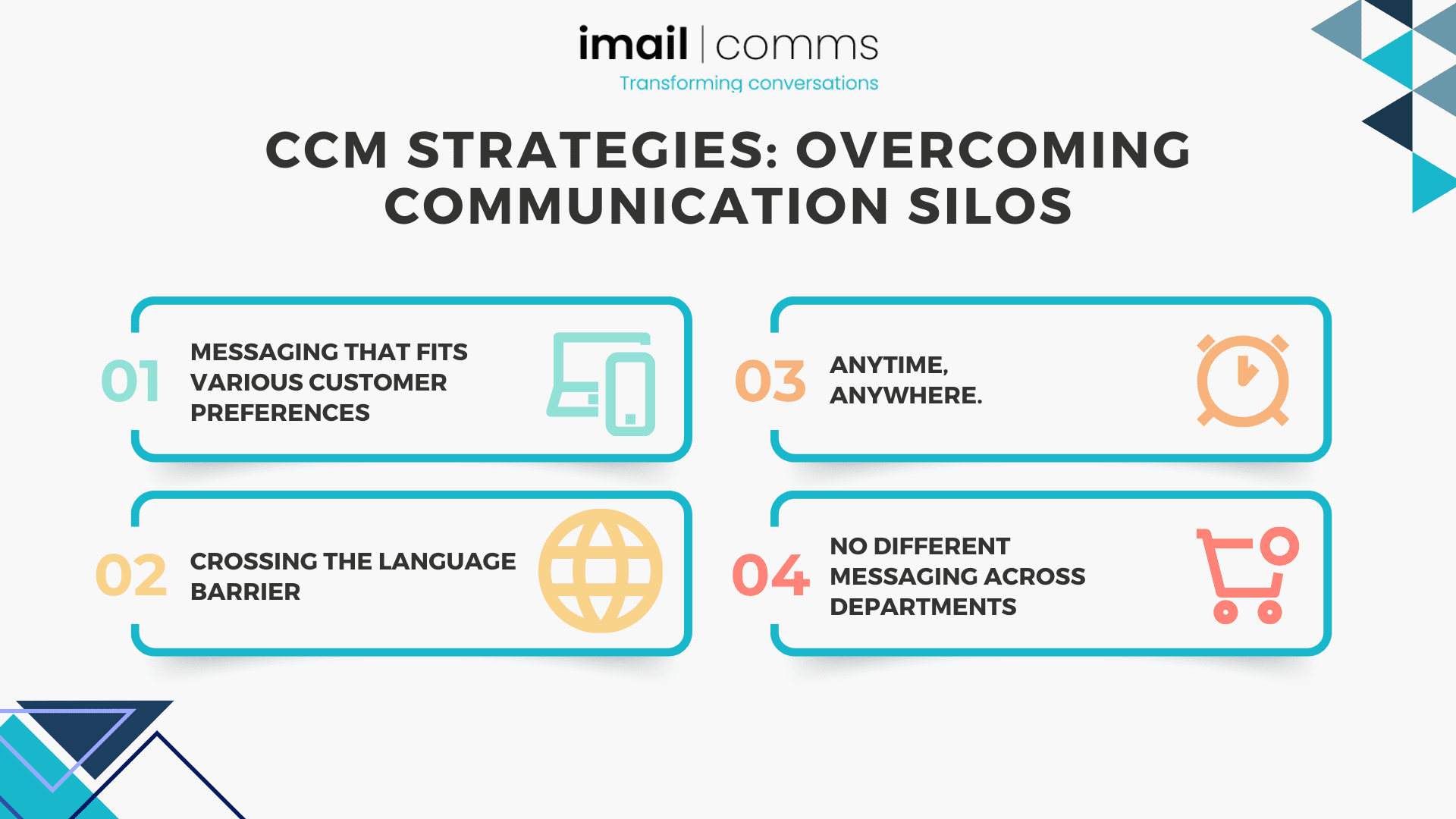A study conducted by Forrester revealed an interesting fact in the field of customer communications: there is no top leader in the Customer Communication Management (CCM) software area.
The Forrester Wave Report highlights that no business can escape the complex issues and challenges of the modern marketing world. In a time when consumer demands are increasing and their preferences are fluctuating, achieving high customer satisfaction and loyalty is becoming increasingly difficult.
Essentially, your brand’s success in engaging customers becomes majorly dependent on manoeuvring around common customer communication problems and challenges.
imal comms has helped over 20,000 customers refine and improve their communication strategy, and we want to help too.
With this guide, you will develop a deeper understanding of how it’s imperative to overcome customer communication management challenges to genuinely create relevant communications and personalised customer interactions.
Exploring the Complexity of Customer Communication Management
Today’s digital-savvy customers expect more from their communications with your brand. This means that your brand has to take on a sophisticated customer communication management (CCM) approach.
This strategy involves aligning multiple channels and media to deliver a cohesive customer experience, which may seem quite difficult to achieve. This is because CCM is a complex system that consists of many layers including creating customised experiences based on what customers expect, achieving operational efficiency, and being attentive to cultural considerations.
But what your brand must know is that integrating all of these layers in your customer communications strategy, while they operate in true working harmony, is your brand’s key to improving customer experiences and enhancing your overall customer engagement.
The Scope and Definition of CCM
Customer communication management focuses on genuine engagement through consistent and meaningful customer interactions across multiple communication channels.
“True loyalty comes from being easy to do business with. It means thinking about the customer’s experience through the entire process, making sure it’s as smooth as possible at every step. If you do that, you’re going to have customers who are more loyal and willing to come back and do business with you again.”
The aim is simple: guide the customer journey from initial interest in your brand to actual loyalty to your business. To lead customer communications, you have to deploy customer data to create a consistent and personalised customer experience across diverse communication channels and digital platforms.
Customisation: A Double-Edged Sword
Customisation can be elemental in the effortless flow of your customer communications across various communication channels. Yet it can also have the ability to produce customer frustration. How?
Customisation offers your business the golden opportunity to cater uniquely all customers, allowing you to develop deeper connections through these communications. Customers feel valued and understood when they receive tailored experiences, which significantly boosts their satisfaction and loyalty.
On the other hand, this level of personalisation requires the collection and analysis of personal customer data for different communication channels, which can raise privacy concerns amongst your clients.
Also, too much customisation might overwhelm customers, causing decision paralysis rather than providing a smooth and helpful experience for your clients.
Hence, while the benefits of customisation are hard to neglect, personalised customer communications must be handled with care to avoid the pitfalls that can accompany excessive focus on individual preferences within your CCM system.
Multinational Workforce and Virtual Teams
A blend of diverse cultural perspectives and geographical dispersion can enhance your brand’s creativity and drive innovation by bringing a wide array of distinctive ideas and solutions to the table.
However, managing such teams requires sophisticated communication strategies and advanced technology to ensure your team’s collaboration is uninterrupted and not time-consuming, even when they’re in different time zones.
Equally important is the encouragement of an inclusive culture that values and integrates these diverse views, ultimately empowering your employees to contribute genuinely regardless of their physical location.
Common Barriers To Customer Communication
The first step to solving a problem is to identify the issues you need to address in the first place.
Let’s explore some of the common customer communication problems, to later examine relevant solutions for each.

Varied Customer Expectations and Preferences
As businesses expand their reach across diverse demographics, they encounter a wide spectrum of demands, from personalised communication preferences to differing technological proficiencies among their customers.
This diversity requires your brand to adopt a highly adaptable and perhaps data-driven approach, tailoring communications not just to broad market segments but to the individual needs and expectations of your customers.
The challenge lies in striking the right balance.
You have to ensure that your customer communications are personal yet scalable, innovative yet accessible. Without sophisticated data analytics and a flexible communication strategy, your business may struggle to connect effectively with each individual customer, which may negatively disrupt the distinctive communication services companies aim to deliver.
The Challenge of Multilingual Communication
The necessity to converse in multiple languages is becoming not just a beneficial element in communications, but a critical one indeed.
This multilingual requirement complicates content creation because it requires not only translation but also cultural adaptation to resonate genuinely with each diverse target audience.
This means that you must take special notice of the linguistic subtle differences and variations in local customs to avoid miscommunications that could lead to customer dissatisfaction or even legal complications.
Advanced translation technologies and employing culturally aware communication strategists can be relevant solutions, but they incur the risk of added complexity and cost.
Time-Zone Disparities and Round-the-Clock Support
Time-zone disparities add a tricky layer to managing customer communications, especially when customers expect support any time of day on any of your brand’s communication channels.
Serving a global audience means someone, somewhere, always needs help, and delivering timely responses around the clock can really stretch your support teams thin.
To keep up, you will often need to get creative with scheduling and might even set up shop in multiple regions. This approach ensures that help is always on hand, but without accurate data, savvy planning and solid tech to back it up, it’s easy to slip into slow responses and unhappy customers.
Uniform Messaging Across Departments
Companies face a big challenge in making sure brand messaging meets individual needs and preferences of their customers, as clients often feel upset when they get different messages from the same company.
Imagine the confusion when Marketing offers a deal but Customer Service knows nothing about it. This leads to a poor and frustrating customer experience and a negative reflection on your brand.
Let’s take a look at the following image that illustrates how different departments often fail in communicating efficiently.

Striving For The Ideal CCM Platform
Finding the ideal Customer Communication Management system can be quite a journey, as nowadays there are ample CCM platforms, each with unique features.
What makes it tough to find the ‘ideal’ CCM is the need for solutions that fit various customer communication types.
Lack of a One-Size-Fits-All Solution
Every business wishes for a CCM solution that can address their common communication problems.
Yet, a one-size-fits-all answer doesn’t exist.
Since customer preferences vary greatly, CCM platforms must be adaptable and able to centralise customer data for efficient outbound communications. This means ensuring you can connect with customers through both traditional marketing and digital marketing services.
Forrester’s Insights on CCM Providers
We dived into this guide with a reveal from Forrester that there are no top leading CCM providers. Below is how providers measure up in key CCM aspects according to the study:
Don’t forget to take a glance at our guide to choosing the best CCM software for your enterprise.
CCM Strategies: Overcoming Communication Silos
Remember the customer communication management challenges and common problems we have previously inspected, it’s time to identify the CCM solutions to implement for each customer satisfaction hurdle.
Messaging That Fits Various Customer Preferences
Every customer comes with a unique set of demands, and to bridge these diverse preferences, businesses must develop flexible communication strategies that cater effectively to all.
Companies must strike the right balance between high-tech solutions for the tech-savvy and more traditional, personable approaches for those who value human connection.
Adopting a hybrid communication strategy that combines digital prowess with empathetic human service ensures that every customer engagement is meaningfully driven across all communication channels, making everyone feel right at home with your brand.
Crossing The Language Barrier
As the business world grows smaller, the need to speak your customers’ languages becomes critical, not just literally, but culturally too.
Overcoming the multilingual challenge isn’t just about translating text; it’s about conveying the right message with cultural sensitivity spanning multiple communication channels, creating an enjoyable and culturally appropriate customer journey.
Employing native speakers and utilising robust translation technologies can help ensure communications resonate authentically with each target audience,
Help your brand cement trust and enhance customer relationships not only across multiple communication channels but across borders too.
Anytime, Anywhere.
Time-zone disparities require businesses to maintain a 24/7 support system that feels local, no matter where customers are calling from, and no matter what time.
Implementing a follow-the-sun model, where customer correspondence duties shift across global centres in different time zones ensures continuous and alert customer service, which in turns guarantees customer satisfaction.
To bridge the gaps and always be able to provide a data-based solution, AI chatbots and automated systems handle routine queries during transitions and off-hours, providing consistent and immediate assistance for all customers, and on their preferred channels as well.
This strategic combination of global staffing, advanced technology, and standardised training ensures a flow of top-notch support around the clock, building a relationship of trust and reliability with your customers worldwide.
No Different Messaging Across Departments
Getting everyone on the same page can often feel like aligning stars. However, clear and consistent messaging and communications across the different departments of your company can help achieve the customer engagement you seek.
A central communication hub can help harmonise messaging between different channels or teams, while regular workshops ensure everyone is up-to-date on how to communicate the brand’s core values and messages, while simultaneously finding ways to consistently improve customer experience.
Encouraging a culture where feedback flows freely also helps keep the communication lines tight and the message crisp across all touchpoints.
Adapting CCM Systems to the Evolving Market Demand
As customer preferences swiftly change, adapting CCM systems becomes critical for ensuring brand survival.
Let’s explore how advancements in technology are enhancing communication and how your company can remain ahead.
Consumer-Driven Technological Innovation
Driven by tech-fond customers, the landscape of CCM is undergoing significant changes.
People are becoming more proficient with technology and expect smoother interactions with companies. CCM systems that align with these expectations offer more personalised and effective communication.
Anticipating Future Trends in Customer Communication
Proactively looking ahead is essential in customer communication. Companies must not only react to changes but also anticipate and shape them.
Managing a system is akin to holding a conversation, and the language of this dialogue is constantly evolving. By tackling the challenges of market demands and utilising data to anticipate future trends, your CCM can offer distinctive customer experiences tailored for the digital data-driven age.
Effective communication is directly linked to customer satisfaction, underscoring the importance of embracing modern digital services.
Quick adaptability will distinguish the leaders of tomorrow. So are you ready to evolve your CCM to meet the vast future demand for technology?
To Wrap It Up
It’s time for your organisation to sharpen its communication strategies and surf the wave of the evolving CCM advancements that are redefining the standards of modern-day marketing.
Every message your business sends out should be clear, impactful, and audience-specific.
Efforts to deliver memorable communication experiences for your customers should just be routine tasks, as they are vital for strengthening your brand’s voice and gaining industry respect. Committing to these strategies shows your dedication to excellence and turns customer interactions into genuine partnerships.
But the journey does not end here.
Tackling CCM challenges and maintaining smooth communications are essential to surpass the expectations of your customers. Become an industry pioneer and revolutionsie your marketing strategy with imail 2.0, the one app to replace them all.
Frequently Asked Questions (FAQ’s)
For further insight into CCM challenges, check our frequently asked questions below.
How can businesses measure the effectiveness of their CCM strategies?
To gauge the success of your CCM technology, you can track metrics like customer satisfaction scores, response times, and engagement rates. Analysing these data points through customer feedback and digital analytics tools offers insights into how well communications are resonating with your target audience.
What role does artificial intelligence play in enhancing CCM?
Artificial intelligence (AI) significantly boosts CCM by enabling personalised customer interactions at scale. AI can analyse vast amounts of data to predict customer preferences, automate responses, and propose solutions any significant challenge companies face.
Can CCM strategies differ by industry, and if so, how?
Yes, CCM strategies often vary by industry due to differing customer expectations and regulatory requirements. For example, the healthcare sector requires strict data privacy compliance, while retail might focus more on personalised communications.






Leave A Comment
You must be logged in to post a comment.